HRM Report: Aldi's Human Resource Management Practices
VerifiedAdded on 2020/07/23
|15
|4307
|456
Report
AI Summary
This report provides a comprehensive analysis of Human Resource Management (HRM) practices, focusing on the case of Aldi. It begins with an introduction to HRM, its purpose, and functions within the organization, followed by an examination of Aldi's HRM functions, including managerial, operative, and advisory roles. The report then delves into the strengths and weaknesses of recruitment and selection processes, both internal and external, and analyzes the benefits of effective HRM, such as reduced employee turnover and improved performance. It also discusses the effectiveness of different HRM practices, including cost-cutting, work-life balance, and training. The report further explores the influence of employee relations on HRM decision-making, emphasizing the importance of healthy workplace relationships. Finally, it touches upon key elements of employment legislation and their impact on HRM, concluding with an overview of the applications of HRM practices within Aldi. The report highlights the importance of strategic HRM in achieving organizational goals and maintaining a productive and satisfied workforce.
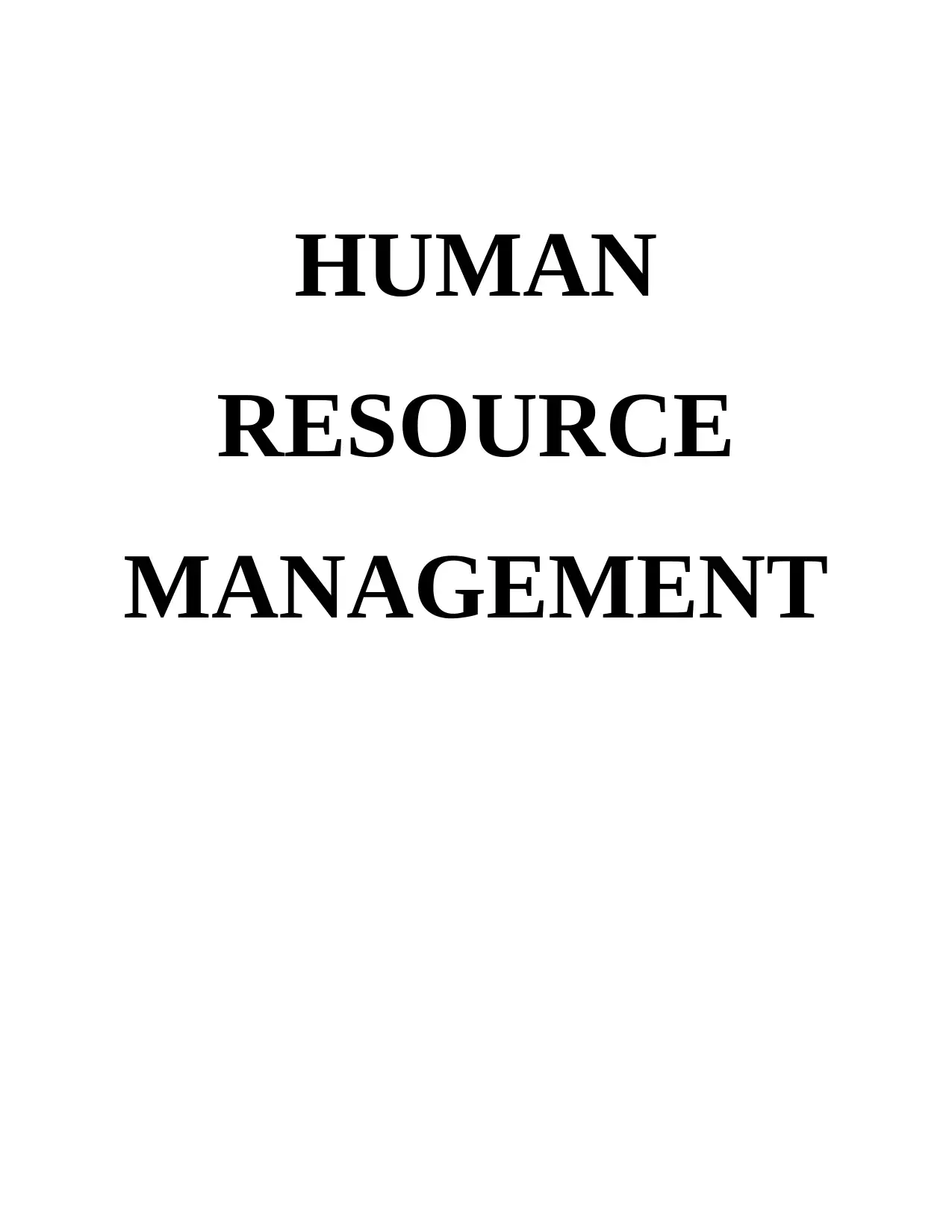
HUMAN
RESOURCE
MANAGEMENT
RESOURCE
MANAGEMENT
Paraphrase This Document
Need a fresh take? Get an instant paraphrase of this document with our AI Paraphraser
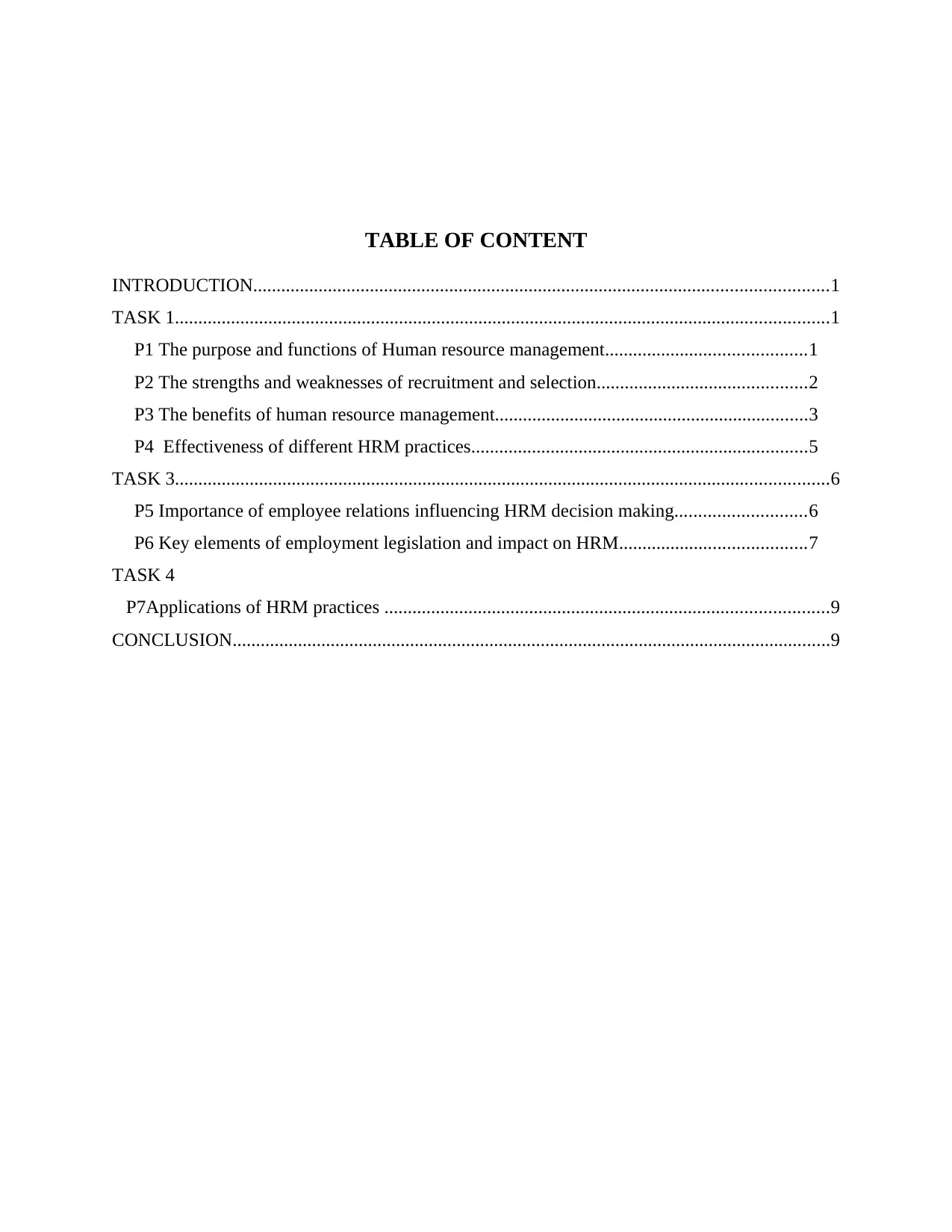
TABLE OF CONTENT
INTRODUCTION...........................................................................................................................1
TASK 1............................................................................................................................................1
P1 The purpose and functions of Human resource management...........................................1
P2 The strengths and weaknesses of recruitment and selection.............................................2
P3 The benefits of human resource management...................................................................3
P4 Effectiveness of different HRM practices........................................................................5
TASK 3............................................................................................................................................6
P5 Importance of employee relations influencing HRM decision making............................6
P6 Key elements of employment legislation and impact on HRM........................................7
TASK 4
P7Applications of HRM practices ...............................................................................................9
CONCLUSION................................................................................................................................9
INTRODUCTION...........................................................................................................................1
TASK 1............................................................................................................................................1
P1 The purpose and functions of Human resource management...........................................1
P2 The strengths and weaknesses of recruitment and selection.............................................2
P3 The benefits of human resource management...................................................................3
P4 Effectiveness of different HRM practices........................................................................5
TASK 3............................................................................................................................................6
P5 Importance of employee relations influencing HRM decision making............................6
P6 Key elements of employment legislation and impact on HRM........................................7
TASK 4
P7Applications of HRM practices ...............................................................................................9
CONCLUSION................................................................................................................................9

⊘ This is a preview!⊘
Do you want full access?
Subscribe today to unlock all pages.

Trusted by 1+ million students worldwide
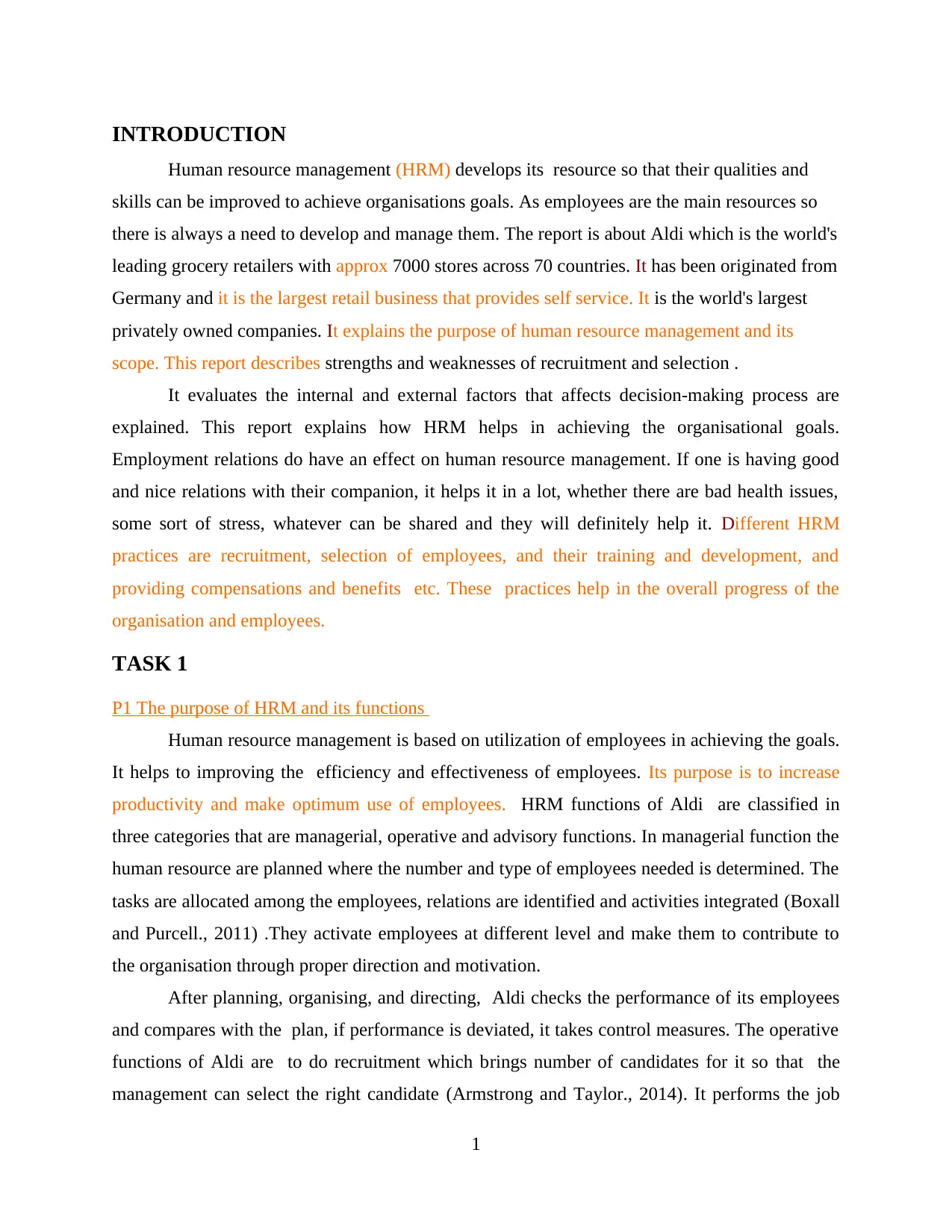
INTRODUCTION
Human resource management (HRM) develops its resource so that their qualities and
skills can be improved to achieve organisations goals. As employees are the main resources so
there is always a need to develop and manage them. The report is about Aldi which is the world's
leading grocery retailers with approx 7000 stores across 70 countries. It has been originated from
Germany and it is the largest retail business that provides self service. It is the world's largest
privately owned companies. It explains the purpose of human resource management and its
scope. This report describes strengths and weaknesses of recruitment and selection .
It evaluates the internal and external factors that affects decision-making process are
explained. This report explains how HRM helps in achieving the organisational goals.
Employment relations do have an effect on human resource management. If one is having good
and nice relations with their companion, it helps it in a lot, whether there are bad health issues,
some sort of stress, whatever can be shared and they will definitely help it. Different HRM
practices are recruitment, selection of employees, and their training and development, and
providing compensations and benefits etc. These practices help in the overall progress of the
organisation and employees.
TASK 1
P1 The purpose of HRM and its functions
Human resource management is based on utilization of employees in achieving the goals.
It helps to improving the efficiency and effectiveness of employees. Its purpose is to increase
productivity and make optimum use of employees. HRM functions of Aldi are classified in
three categories that are managerial, operative and advisory functions. In managerial function the
human resource are planned where the number and type of employees needed is determined. The
tasks are allocated among the employees, relations are identified and activities integrated (Boxall
and Purcell., 2011) .They activate employees at different level and make them to contribute to
the organisation through proper direction and motivation.
After planning, organising, and directing, Aldi checks the performance of its employees
and compares with the plan, if performance is deviated, it takes control measures. The operative
functions of Aldi are to do recruitment which brings number of candidates for it so that the
management can select the right candidate (Armstrong and Taylor., 2014). It performs the job
1
Human resource management (HRM) develops its resource so that their qualities and
skills can be improved to achieve organisations goals. As employees are the main resources so
there is always a need to develop and manage them. The report is about Aldi which is the world's
leading grocery retailers with approx 7000 stores across 70 countries. It has been originated from
Germany and it is the largest retail business that provides self service. It is the world's largest
privately owned companies. It explains the purpose of human resource management and its
scope. This report describes strengths and weaknesses of recruitment and selection .
It evaluates the internal and external factors that affects decision-making process are
explained. This report explains how HRM helps in achieving the organisational goals.
Employment relations do have an effect on human resource management. If one is having good
and nice relations with their companion, it helps it in a lot, whether there are bad health issues,
some sort of stress, whatever can be shared and they will definitely help it. Different HRM
practices are recruitment, selection of employees, and their training and development, and
providing compensations and benefits etc. These practices help in the overall progress of the
organisation and employees.
TASK 1
P1 The purpose of HRM and its functions
Human resource management is based on utilization of employees in achieving the goals.
It helps to improving the efficiency and effectiveness of employees. Its purpose is to increase
productivity and make optimum use of employees. HRM functions of Aldi are classified in
three categories that are managerial, operative and advisory functions. In managerial function the
human resource are planned where the number and type of employees needed is determined. The
tasks are allocated among the employees, relations are identified and activities integrated (Boxall
and Purcell., 2011) .They activate employees at different level and make them to contribute to
the organisation through proper direction and motivation.
After planning, organising, and directing, Aldi checks the performance of its employees
and compares with the plan, if performance is deviated, it takes control measures. The operative
functions of Aldi are to do recruitment which brings number of candidates for it so that the
management can select the right candidate (Armstrong and Taylor., 2014). It performs the job
1
Paraphrase This Document
Need a fresh take? Get an instant paraphrase of this document with our AI Paraphraser
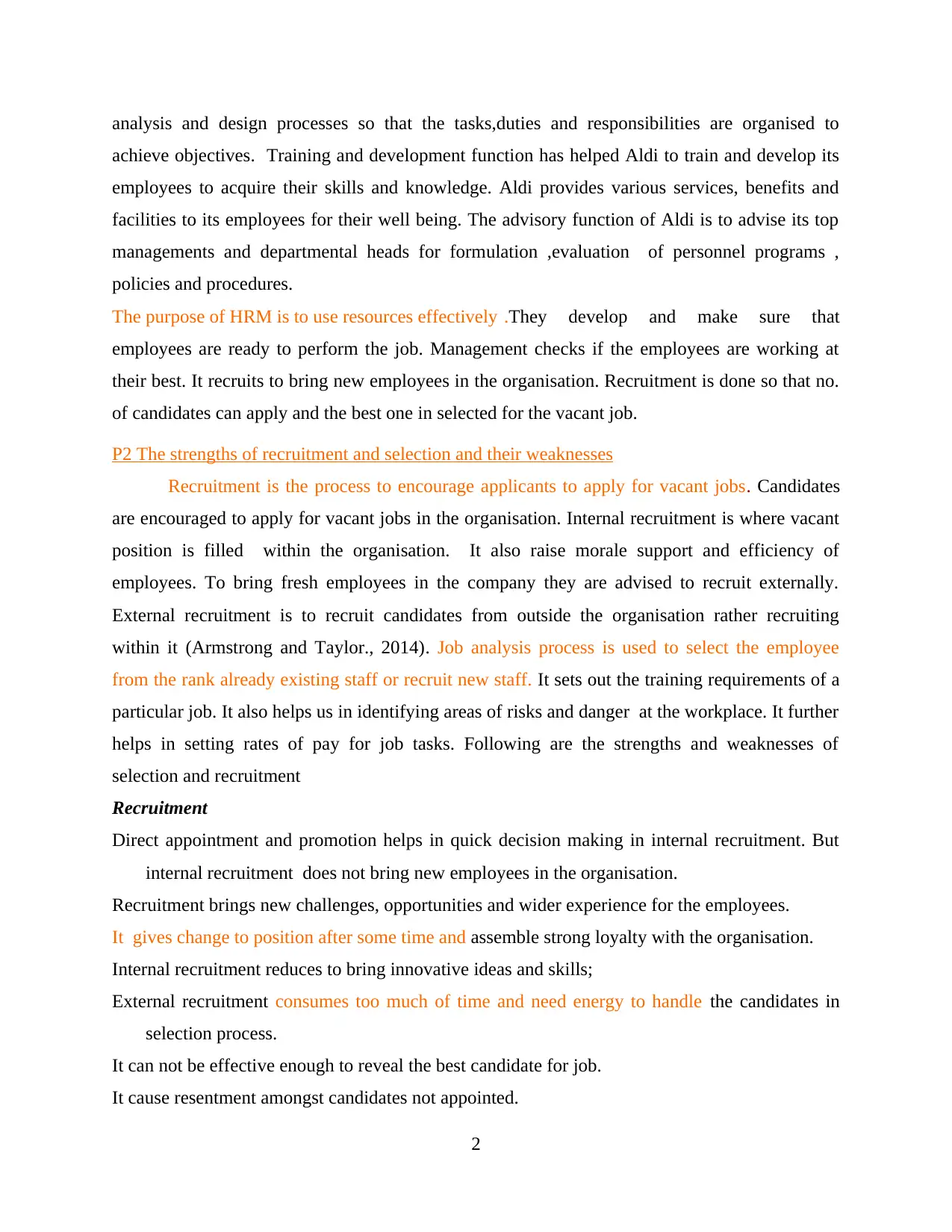
analysis and design processes so that the tasks,duties and responsibilities are organised to
achieve objectives. Training and development function has helped Aldi to train and develop its
employees to acquire their skills and knowledge. Aldi provides various services, benefits and
facilities to its employees for their well being. The advisory function of Aldi is to advise its top
managements and departmental heads for formulation ,evaluation of personnel programs ,
policies and procedures.
The purpose of HRM is to use resources effectively .They develop and make sure that
employees are ready to perform the job. Management checks if the employees are working at
their best. It recruits to bring new employees in the organisation. Recruitment is done so that no.
of candidates can apply and the best one in selected for the vacant job.
P2 The strengths of recruitment and selection and their weaknesses
Recruitment is the process to encourage applicants to apply for vacant jobs. Candidates
are encouraged to apply for vacant jobs in the organisation. Internal recruitment is where vacant
position is filled within the organisation. It also raise morale support and efficiency of
employees. To bring fresh employees in the company they are advised to recruit externally.
External recruitment is to recruit candidates from outside the organisation rather recruiting
within it (Armstrong and Taylor., 2014). Job analysis process is used to select the employee
from the rank already existing staff or recruit new staff. It sets out the training requirements of a
particular job. It also helps us in identifying areas of risks and danger at the workplace. It further
helps in setting rates of pay for job tasks. Following are the strengths and weaknesses of
selection and recruitment
Recruitment
Direct appointment and promotion helps in quick decision making in internal recruitment. But
internal recruitment does not bring new employees in the organisation.
Recruitment brings new challenges, opportunities and wider experience for the employees.
It gives change to position after some time and assemble strong loyalty with the organisation.
Internal recruitment reduces to bring innovative ideas and skills;
External recruitment consumes too much of time and need energy to handle the candidates in
selection process.
It can not be effective enough to reveal the best candidate for job.
It cause resentment amongst candidates not appointed.
2
achieve objectives. Training and development function has helped Aldi to train and develop its
employees to acquire their skills and knowledge. Aldi provides various services, benefits and
facilities to its employees for their well being. The advisory function of Aldi is to advise its top
managements and departmental heads for formulation ,evaluation of personnel programs ,
policies and procedures.
The purpose of HRM is to use resources effectively .They develop and make sure that
employees are ready to perform the job. Management checks if the employees are working at
their best. It recruits to bring new employees in the organisation. Recruitment is done so that no.
of candidates can apply and the best one in selected for the vacant job.
P2 The strengths of recruitment and selection and their weaknesses
Recruitment is the process to encourage applicants to apply for vacant jobs. Candidates
are encouraged to apply for vacant jobs in the organisation. Internal recruitment is where vacant
position is filled within the organisation. It also raise morale support and efficiency of
employees. To bring fresh employees in the company they are advised to recruit externally.
External recruitment is to recruit candidates from outside the organisation rather recruiting
within it (Armstrong and Taylor., 2014). Job analysis process is used to select the employee
from the rank already existing staff or recruit new staff. It sets out the training requirements of a
particular job. It also helps us in identifying areas of risks and danger at the workplace. It further
helps in setting rates of pay for job tasks. Following are the strengths and weaknesses of
selection and recruitment
Recruitment
Direct appointment and promotion helps in quick decision making in internal recruitment. But
internal recruitment does not bring new employees in the organisation.
Recruitment brings new challenges, opportunities and wider experience for the employees.
It gives change to position after some time and assemble strong loyalty with the organisation.
Internal recruitment reduces to bring innovative ideas and skills;
External recruitment consumes too much of time and need energy to handle the candidates in
selection process.
It can not be effective enough to reveal the best candidate for job.
It cause resentment amongst candidates not appointed.
2
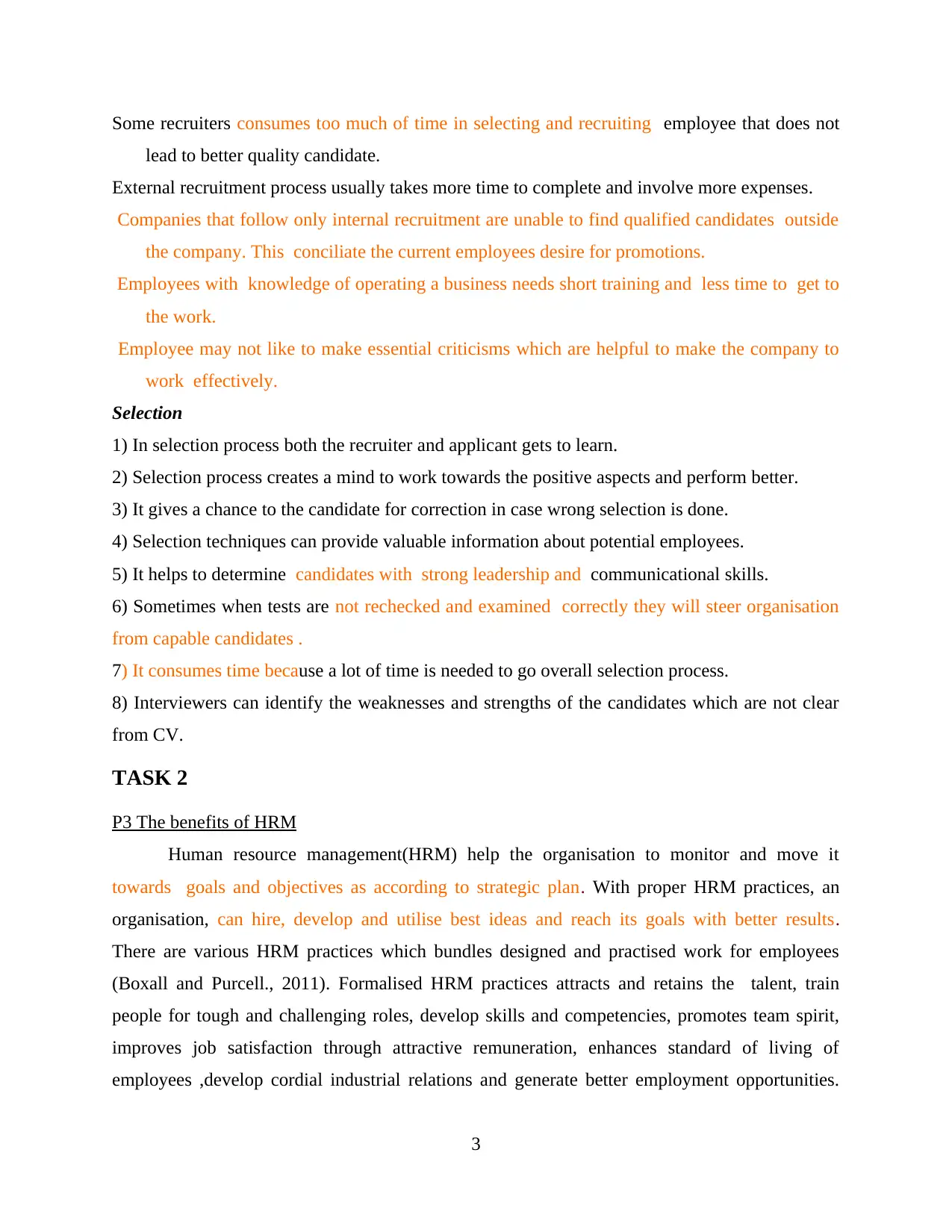
Some recruiters consumes too much of time in selecting and recruiting employee that does not
lead to better quality candidate.
External recruitment process usually takes more time to complete and involve more expenses.
Companies that follow only internal recruitment are unable to find qualified candidates outside
the company. This conciliate the current employees desire for promotions.
Employees with knowledge of operating a business needs short training and less time to get to
the work.
Employee may not like to make essential criticisms which are helpful to make the company to
work effectively.
Selection
1) In selection process both the recruiter and applicant gets to learn.
2) Selection process creates a mind to work towards the positive aspects and perform better.
3) It gives a chance to the candidate for correction in case wrong selection is done.
4) Selection techniques can provide valuable information about potential employees.
5) It helps to determine candidates with strong leadership and communicational skills.
6) Sometimes when tests are not rechecked and examined correctly they will steer organisation
from capable candidates .
7) It consumes time because a lot of time is needed to go overall selection process.
8) Interviewers can identify the weaknesses and strengths of the candidates which are not clear
from CV.
TASK 2
P3 The benefits of HRM
Human resource management(HRM) help the organisation to monitor and move it
towards goals and objectives as according to strategic plan. With proper HRM practices, an
organisation, can hire, develop and utilise best ideas and reach its goals with better results.
There are various HRM practices which bundles designed and practised work for employees
(Boxall and Purcell., 2011). Formalised HRM practices attracts and retains the talent, train
people for tough and challenging roles, develop skills and competencies, promotes team spirit,
improves job satisfaction through attractive remuneration, enhances standard of living of
employees ,develop cordial industrial relations and generate better employment opportunities.
3
lead to better quality candidate.
External recruitment process usually takes more time to complete and involve more expenses.
Companies that follow only internal recruitment are unable to find qualified candidates outside
the company. This conciliate the current employees desire for promotions.
Employees with knowledge of operating a business needs short training and less time to get to
the work.
Employee may not like to make essential criticisms which are helpful to make the company to
work effectively.
Selection
1) In selection process both the recruiter and applicant gets to learn.
2) Selection process creates a mind to work towards the positive aspects and perform better.
3) It gives a chance to the candidate for correction in case wrong selection is done.
4) Selection techniques can provide valuable information about potential employees.
5) It helps to determine candidates with strong leadership and communicational skills.
6) Sometimes when tests are not rechecked and examined correctly they will steer organisation
from capable candidates .
7) It consumes time because a lot of time is needed to go overall selection process.
8) Interviewers can identify the weaknesses and strengths of the candidates which are not clear
from CV.
TASK 2
P3 The benefits of HRM
Human resource management(HRM) help the organisation to monitor and move it
towards goals and objectives as according to strategic plan. With proper HRM practices, an
organisation, can hire, develop and utilise best ideas and reach its goals with better results.
There are various HRM practices which bundles designed and practised work for employees
(Boxall and Purcell., 2011). Formalised HRM practices attracts and retains the talent, train
people for tough and challenging roles, develop skills and competencies, promotes team spirit,
improves job satisfaction through attractive remuneration, enhances standard of living of
employees ,develop cordial industrial relations and generate better employment opportunities.
3
⊘ This is a preview!⊘
Do you want full access?
Subscribe today to unlock all pages.

Trusted by 1+ million students worldwide

Aldi has got its formalistic HR practice bundles which has a direct impact on the employees
productivity and performance. The benefits of human resource management are-
1) Decreases employee turnover- The organisation should see that it hires the right person
from beginning. Interviews should be conducted carefully not just to ensure the skills of
candidates but also to check weather they are fit for the company (Jiang and et.al., 2012).
Human resource should pay attention to employees needs which help to decrease the
employee turnover.
2) Handles conflicts- In organisation every employee have different personality, lifestyle,
nature and work ethic. So conflicts can arise between employees or employee or
management. HRM handles the situation and settles the conflicts without choosing any
side.
3) Satisfy employees- Human resource management has the responsibility to determine
the employees satisfaction. It conducts surveys and focus on groups to determine if they
are satisfied or not. They brings out the causes of employees dissatisfaction and solve
those issues with creative solutions.
4) Improve employee performance- HRM helps in increasing employee performance by
guiding them, giving them proper training and induction so that they will be able to face
any situation.
5) Helps evaluate HR policies – The main focus of the HRM strategy is to fit in the
procedures and policies of an organisation in the strategic plan of the company. (Jiang
and et.al., 2012). After the HR policies are being evaluated, goals of HR policies are
being used for assessing the processes.
6) Group Building – In an organisation, strategic Human resource management helps in
encouraging morale of the team and the companions. A wide range of stakeholders
depend on the calculated vision of the organisation . It includes customers, executives
and the bondholders.
7) Recording the development – Human resource management keeps a record about the
achievement of goals and targets that are included in the strategic plan. The role of HR is
to keep a record if the goals and targets are being done in an honest and effective way.
8) Maintains the Organisation judicial – HRM holds a big advantage to keep the company
adaptable w.r.t the legislations that are related to the employees, salary, insurance etc.
4
productivity and performance. The benefits of human resource management are-
1) Decreases employee turnover- The organisation should see that it hires the right person
from beginning. Interviews should be conducted carefully not just to ensure the skills of
candidates but also to check weather they are fit for the company (Jiang and et.al., 2012).
Human resource should pay attention to employees needs which help to decrease the
employee turnover.
2) Handles conflicts- In organisation every employee have different personality, lifestyle,
nature and work ethic. So conflicts can arise between employees or employee or
management. HRM handles the situation and settles the conflicts without choosing any
side.
3) Satisfy employees- Human resource management has the responsibility to determine
the employees satisfaction. It conducts surveys and focus on groups to determine if they
are satisfied or not. They brings out the causes of employees dissatisfaction and solve
those issues with creative solutions.
4) Improve employee performance- HRM helps in increasing employee performance by
guiding them, giving them proper training and induction so that they will be able to face
any situation.
5) Helps evaluate HR policies – The main focus of the HRM strategy is to fit in the
procedures and policies of an organisation in the strategic plan of the company. (Jiang
and et.al., 2012). After the HR policies are being evaluated, goals of HR policies are
being used for assessing the processes.
6) Group Building – In an organisation, strategic Human resource management helps in
encouraging morale of the team and the companions. A wide range of stakeholders
depend on the calculated vision of the organisation . It includes customers, executives
and the bondholders.
7) Recording the development – Human resource management keeps a record about the
achievement of goals and targets that are included in the strategic plan. The role of HR is
to keep a record if the goals and targets are being done in an honest and effective way.
8) Maintains the Organisation judicial – HRM holds a big advantage to keep the company
adaptable w.r.t the legislations that are related to the employees, salary, insurance etc.
4
Paraphrase This Document
Need a fresh take? Get an instant paraphrase of this document with our AI Paraphraser
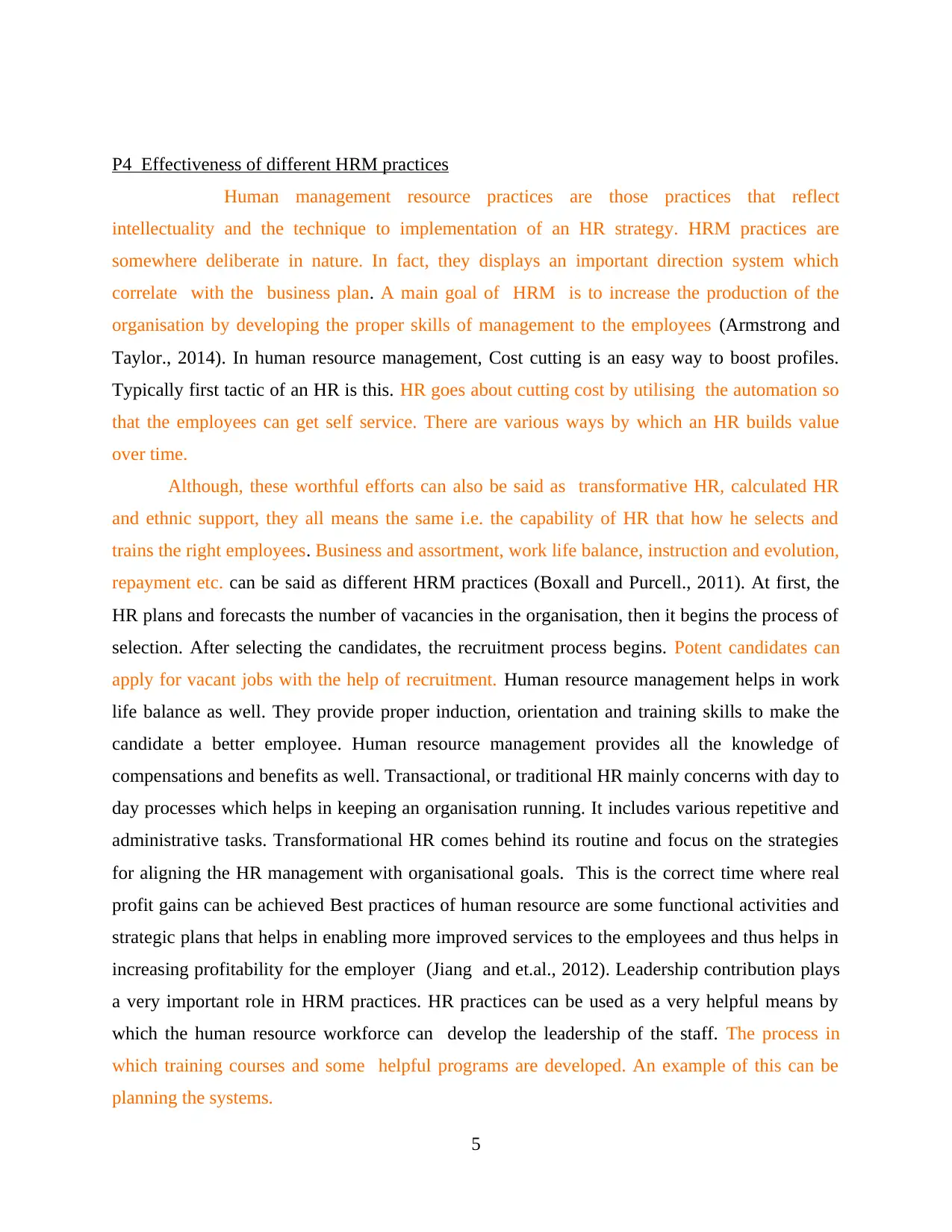
P4 Effectiveness of different HRM practices
Human management resource practices are those practices that reflect
intellectuality and the technique to implementation of an HR strategy. HRM practices are
somewhere deliberate in nature. In fact, they displays an important direction system which
correlate with the business plan. A main goal of HRM is to increase the production of the
organisation by developing the proper skills of management to the employees (Armstrong and
Taylor., 2014). In human resource management, Cost cutting is an easy way to boost profiles.
Typically first tactic of an HR is this. HR goes about cutting cost by utilising the automation so
that the employees can get self service. There are various ways by which an HR builds value
over time.
Although, these worthful efforts can also be said as transformative HR, calculated HR
and ethnic support, they all means the same i.e. the capability of HR that how he selects and
trains the right employees. Business and assortment, work life balance, instruction and evolution,
repayment etc. can be said as different HRM practices (Boxall and Purcell., 2011). At first, the
HR plans and forecasts the number of vacancies in the organisation, then it begins the process of
selection. After selecting the candidates, the recruitment process begins. Potent candidates can
apply for vacant jobs with the help of recruitment. Human resource management helps in work
life balance as well. They provide proper induction, orientation and training skills to make the
candidate a better employee. Human resource management provides all the knowledge of
compensations and benefits as well. Transactional, or traditional HR mainly concerns with day to
day processes which helps in keeping an organisation running. It includes various repetitive and
administrative tasks. Transformational HR comes behind its routine and focus on the strategies
for aligning the HR management with organisational goals. This is the correct time where real
profit gains can be achieved Best practices of human resource are some functional activities and
strategic plans that helps in enabling more improved services to the employees and thus helps in
increasing profitability for the employer (Jiang and et.al., 2012). Leadership contribution plays
a very important role in HRM practices. HR practices can be used as a very helpful means by
which the human resource workforce can develop the leadership of the staff. The process in
which training courses and some helpful programs are developed. An example of this can be
planning the systems.
5
Human management resource practices are those practices that reflect
intellectuality and the technique to implementation of an HR strategy. HRM practices are
somewhere deliberate in nature. In fact, they displays an important direction system which
correlate with the business plan. A main goal of HRM is to increase the production of the
organisation by developing the proper skills of management to the employees (Armstrong and
Taylor., 2014). In human resource management, Cost cutting is an easy way to boost profiles.
Typically first tactic of an HR is this. HR goes about cutting cost by utilising the automation so
that the employees can get self service. There are various ways by which an HR builds value
over time.
Although, these worthful efforts can also be said as transformative HR, calculated HR
and ethnic support, they all means the same i.e. the capability of HR that how he selects and
trains the right employees. Business and assortment, work life balance, instruction and evolution,
repayment etc. can be said as different HRM practices (Boxall and Purcell., 2011). At first, the
HR plans and forecasts the number of vacancies in the organisation, then it begins the process of
selection. After selecting the candidates, the recruitment process begins. Potent candidates can
apply for vacant jobs with the help of recruitment. Human resource management helps in work
life balance as well. They provide proper induction, orientation and training skills to make the
candidate a better employee. Human resource management provides all the knowledge of
compensations and benefits as well. Transactional, or traditional HR mainly concerns with day to
day processes which helps in keeping an organisation running. It includes various repetitive and
administrative tasks. Transformational HR comes behind its routine and focus on the strategies
for aligning the HR management with organisational goals. This is the correct time where real
profit gains can be achieved Best practices of human resource are some functional activities and
strategic plans that helps in enabling more improved services to the employees and thus helps in
increasing profitability for the employer (Jiang and et.al., 2012). Leadership contribution plays
a very important role in HRM practices. HR practices can be used as a very helpful means by
which the human resource workforce can develop the leadership of the staff. The process in
which training courses and some helpful programs are developed. An example of this can be
planning the systems.
5
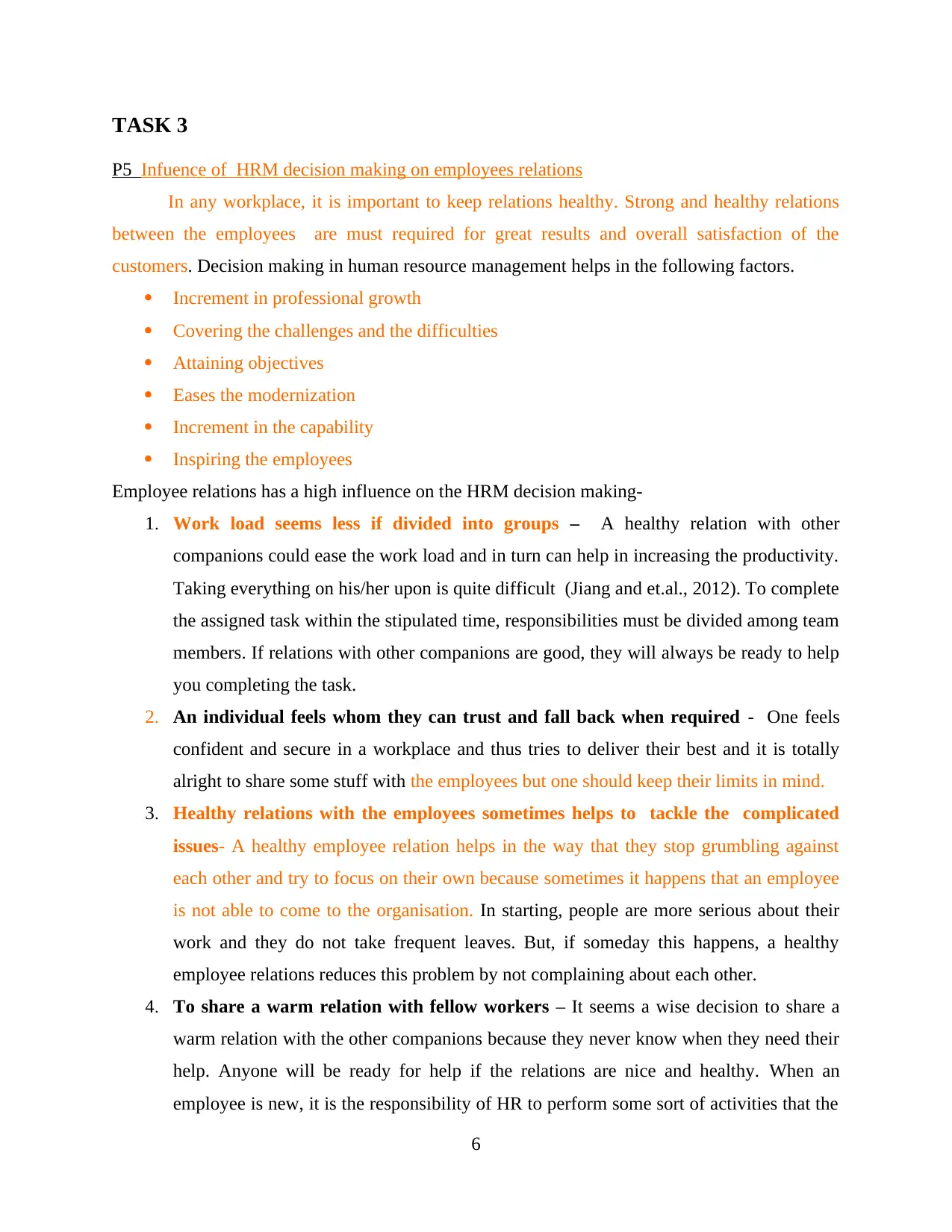
TASK 3
P5 Infuence of HRM decision making on employees relations
In any workplace, it is important to keep relations healthy. Strong and healthy relations
between the employees are must required for great results and overall satisfaction of the
customers. Decision making in human resource management helps in the following factors.
Increment in professional growth
Covering the challenges and the difficulties
Attaining objectives
Eases the modernization
Increment in the capability
Inspiring the employees
Employee relations has a high influence on the HRM decision making-
1. Work load seems less if divided into groups – A healthy relation with other
companions could ease the work load and in turn can help in increasing the productivity.
Taking everything on his/her upon is quite difficult (Jiang and et.al., 2012). To complete
the assigned task within the stipulated time, responsibilities must be divided among team
members. If relations with other companions are good, they will always be ready to help
you completing the task.
2. An individual feels whom they can trust and fall back when required - One feels
confident and secure in a workplace and thus tries to deliver their best and it is totally
alright to share some stuff with the employees but one should keep their limits in mind.
3. Healthy relations with the employees sometimes helps to tackle the complicated
issues- A healthy employee relation helps in the way that they stop grumbling against
each other and try to focus on their own because sometimes it happens that an employee
is not able to come to the organisation. In starting, people are more serious about their
work and they do not take frequent leaves. But, if someday this happens, a healthy
employee relations reduces this problem by not complaining about each other.
4. To share a warm relation with fellow workers – It seems a wise decision to share a
warm relation with the other companions because they never know when they need their
help. Anyone will be ready for help if the relations are nice and healthy. When an
employee is new, it is the responsibility of HR to perform some sort of activities that the
6
P5 Infuence of HRM decision making on employees relations
In any workplace, it is important to keep relations healthy. Strong and healthy relations
between the employees are must required for great results and overall satisfaction of the
customers. Decision making in human resource management helps in the following factors.
Increment in professional growth
Covering the challenges and the difficulties
Attaining objectives
Eases the modernization
Increment in the capability
Inspiring the employees
Employee relations has a high influence on the HRM decision making-
1. Work load seems less if divided into groups – A healthy relation with other
companions could ease the work load and in turn can help in increasing the productivity.
Taking everything on his/her upon is quite difficult (Jiang and et.al., 2012). To complete
the assigned task within the stipulated time, responsibilities must be divided among team
members. If relations with other companions are good, they will always be ready to help
you completing the task.
2. An individual feels whom they can trust and fall back when required - One feels
confident and secure in a workplace and thus tries to deliver their best and it is totally
alright to share some stuff with the employees but one should keep their limits in mind.
3. Healthy relations with the employees sometimes helps to tackle the complicated
issues- A healthy employee relation helps in the way that they stop grumbling against
each other and try to focus on their own because sometimes it happens that an employee
is not able to come to the organisation. In starting, people are more serious about their
work and they do not take frequent leaves. But, if someday this happens, a healthy
employee relations reduces this problem by not complaining about each other.
4. To share a warm relation with fellow workers – It seems a wise decision to share a
warm relation with the other companions because they never know when they need their
help. Anyone will be ready for help if the relations are nice and healthy. When an
employee is new, it is the responsibility of HR to perform some sort of activities that the
6
⊘ This is a preview!⊘
Do you want full access?
Subscribe today to unlock all pages.

Trusted by 1+ million students worldwide
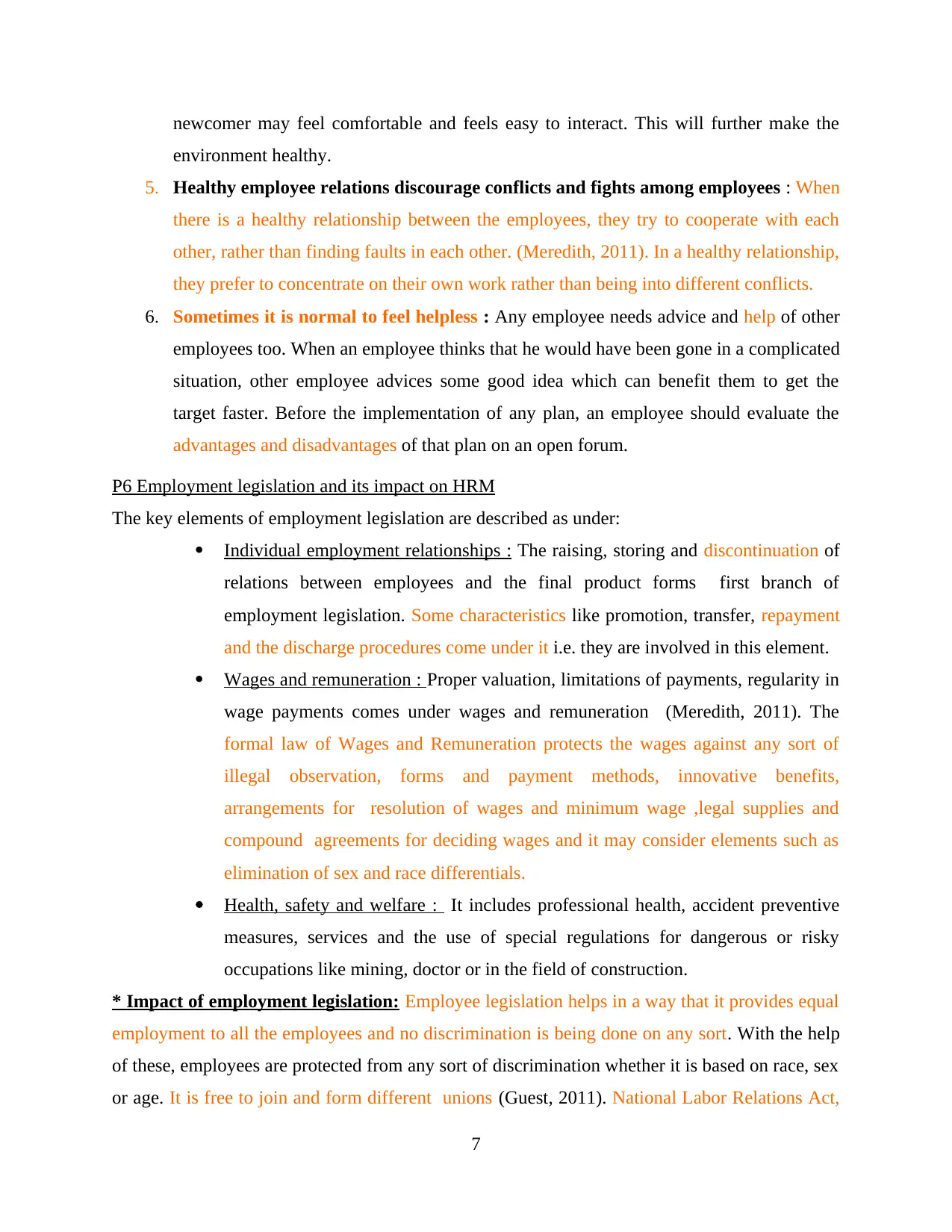
newcomer may feel comfortable and feels easy to interact. This will further make the
environment healthy.
5. Healthy employee relations discourage conflicts and fights among employees : When
there is a healthy relationship between the employees, they try to cooperate with each
other, rather than finding faults in each other. (Meredith, 2011). In a healthy relationship,
they prefer to concentrate on their own work rather than being into different conflicts.
6. Sometimes it is normal to feel helpless : Any employee needs advice and help of other
employees too. When an employee thinks that he would have been gone in a complicated
situation, other employee advices some good idea which can benefit them to get the
target faster. Before the implementation of any plan, an employee should evaluate the
advantages and disadvantages of that plan on an open forum.
P6 Employment legislation and its impact on HRM
The key elements of employment legislation are described as under:
Individual employment relationships : The raising, storing and discontinuation of
relations between employees and the final product forms first branch of
employment legislation. Some characteristics like promotion, transfer, repayment
and the discharge procedures come under it i.e. they are involved in this element.
Wages and remuneration : Proper valuation, limitations of payments, regularity in
wage payments comes under wages and remuneration (Meredith, 2011). The
formal law of Wages and Remuneration protects the wages against any sort of
illegal observation, forms and payment methods, innovative benefits,
arrangements for resolution of wages and minimum wage ,legal supplies and
compound agreements for deciding wages and it may consider elements such as
elimination of sex and race differentials.
Health, safety and welfare : It includes professional health, accident preventive
measures, services and the use of special regulations for dangerous or risky
occupations like mining, doctor or in the field of construction.
* Impact of employment legislation: Employee legislation helps in a way that it provides equal
employment to all the employees and no discrimination is being done on any sort. With the help
of these, employees are protected from any sort of discrimination whether it is based on race, sex
or age. It is free to join and form different unions (Guest, 2011). National Labor Relations Act,
7
environment healthy.
5. Healthy employee relations discourage conflicts and fights among employees : When
there is a healthy relationship between the employees, they try to cooperate with each
other, rather than finding faults in each other. (Meredith, 2011). In a healthy relationship,
they prefer to concentrate on their own work rather than being into different conflicts.
6. Sometimes it is normal to feel helpless : Any employee needs advice and help of other
employees too. When an employee thinks that he would have been gone in a complicated
situation, other employee advices some good idea which can benefit them to get the
target faster. Before the implementation of any plan, an employee should evaluate the
advantages and disadvantages of that plan on an open forum.
P6 Employment legislation and its impact on HRM
The key elements of employment legislation are described as under:
Individual employment relationships : The raising, storing and discontinuation of
relations between employees and the final product forms first branch of
employment legislation. Some characteristics like promotion, transfer, repayment
and the discharge procedures come under it i.e. they are involved in this element.
Wages and remuneration : Proper valuation, limitations of payments, regularity in
wage payments comes under wages and remuneration (Meredith, 2011). The
formal law of Wages and Remuneration protects the wages against any sort of
illegal observation, forms and payment methods, innovative benefits,
arrangements for resolution of wages and minimum wage ,legal supplies and
compound agreements for deciding wages and it may consider elements such as
elimination of sex and race differentials.
Health, safety and welfare : It includes professional health, accident preventive
measures, services and the use of special regulations for dangerous or risky
occupations like mining, doctor or in the field of construction.
* Impact of employment legislation: Employee legislation helps in a way that it provides equal
employment to all the employees and no discrimination is being done on any sort. With the help
of these, employees are protected from any sort of discrimination whether it is based on race, sex
or age. It is free to join and form different unions (Guest, 2011). National Labor Relations Act,
7
Paraphrase This Document
Need a fresh take? Get an instant paraphrase of this document with our AI Paraphraser
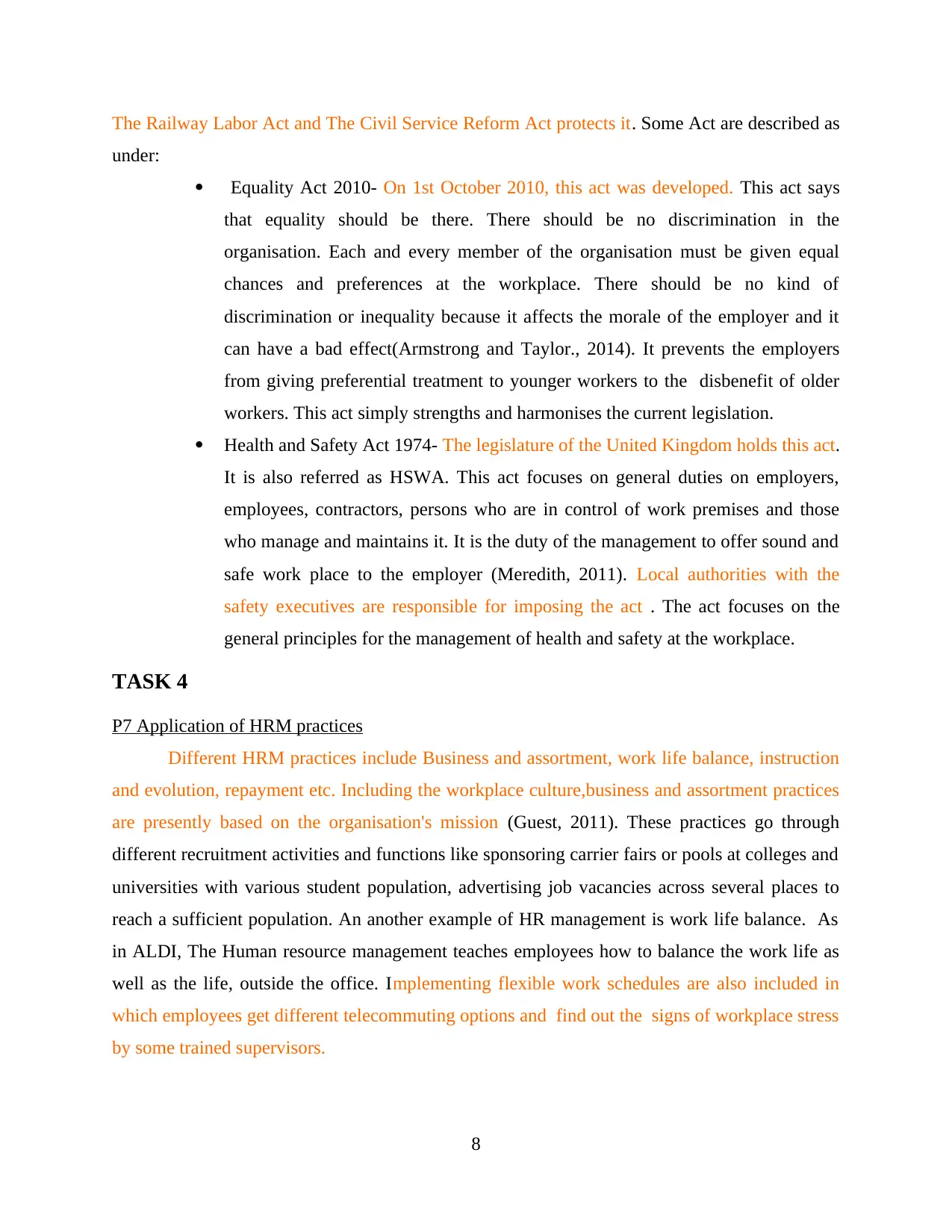
The Railway Labor Act and The Civil Service Reform Act protects it. Some Act are described as
under:
Equality Act 2010- On 1st October 2010, this act was developed. This act says
that equality should be there. There should be no discrimination in the
organisation. Each and every member of the organisation must be given equal
chances and preferences at the workplace. There should be no kind of
discrimination or inequality because it affects the morale of the employer and it
can have a bad effect(Armstrong and Taylor., 2014). It prevents the employers
from giving preferential treatment to younger workers to the disbenefit of older
workers. This act simply strengths and harmonises the current legislation.
Health and Safety Act 1974- The legislature of the United Kingdom holds this act.
It is also referred as HSWA. This act focuses on general duties on employers,
employees, contractors, persons who are in control of work premises and those
who manage and maintains it. It is the duty of the management to offer sound and
safe work place to the employer (Meredith, 2011). Local authorities with the
safety executives are responsible for imposing the act . The act focuses on the
general principles for the management of health and safety at the workplace.
TASK 4
P7 Application of HRM practices
Different HRM practices include Business and assortment, work life balance, instruction
and evolution, repayment etc. Including the workplace culture,business and assortment practices
are presently based on the organisation's mission (Guest, 2011). These practices go through
different recruitment activities and functions like sponsoring carrier fairs or pools at colleges and
universities with various student population, advertising job vacancies across several places to
reach a sufficient population. An another example of HR management is work life balance. As
in ALDI, The Human resource management teaches employees how to balance the work life as
well as the life, outside the office. Implementing flexible work schedules are also included in
which employees get different telecommuting options and find out the signs of workplace stress
by some trained supervisors.
8
under:
Equality Act 2010- On 1st October 2010, this act was developed. This act says
that equality should be there. There should be no discrimination in the
organisation. Each and every member of the organisation must be given equal
chances and preferences at the workplace. There should be no kind of
discrimination or inequality because it affects the morale of the employer and it
can have a bad effect(Armstrong and Taylor., 2014). It prevents the employers
from giving preferential treatment to younger workers to the disbenefit of older
workers. This act simply strengths and harmonises the current legislation.
Health and Safety Act 1974- The legislature of the United Kingdom holds this act.
It is also referred as HSWA. This act focuses on general duties on employers,
employees, contractors, persons who are in control of work premises and those
who manage and maintains it. It is the duty of the management to offer sound and
safe work place to the employer (Meredith, 2011). Local authorities with the
safety executives are responsible for imposing the act . The act focuses on the
general principles for the management of health and safety at the workplace.
TASK 4
P7 Application of HRM practices
Different HRM practices include Business and assortment, work life balance, instruction
and evolution, repayment etc. Including the workplace culture,business and assortment practices
are presently based on the organisation's mission (Guest, 2011). These practices go through
different recruitment activities and functions like sponsoring carrier fairs or pools at colleges and
universities with various student population, advertising job vacancies across several places to
reach a sufficient population. An another example of HR management is work life balance. As
in ALDI, The Human resource management teaches employees how to balance the work life as
well as the life, outside the office. Implementing flexible work schedules are also included in
which employees get different telecommuting options and find out the signs of workplace stress
by some trained supervisors.
8
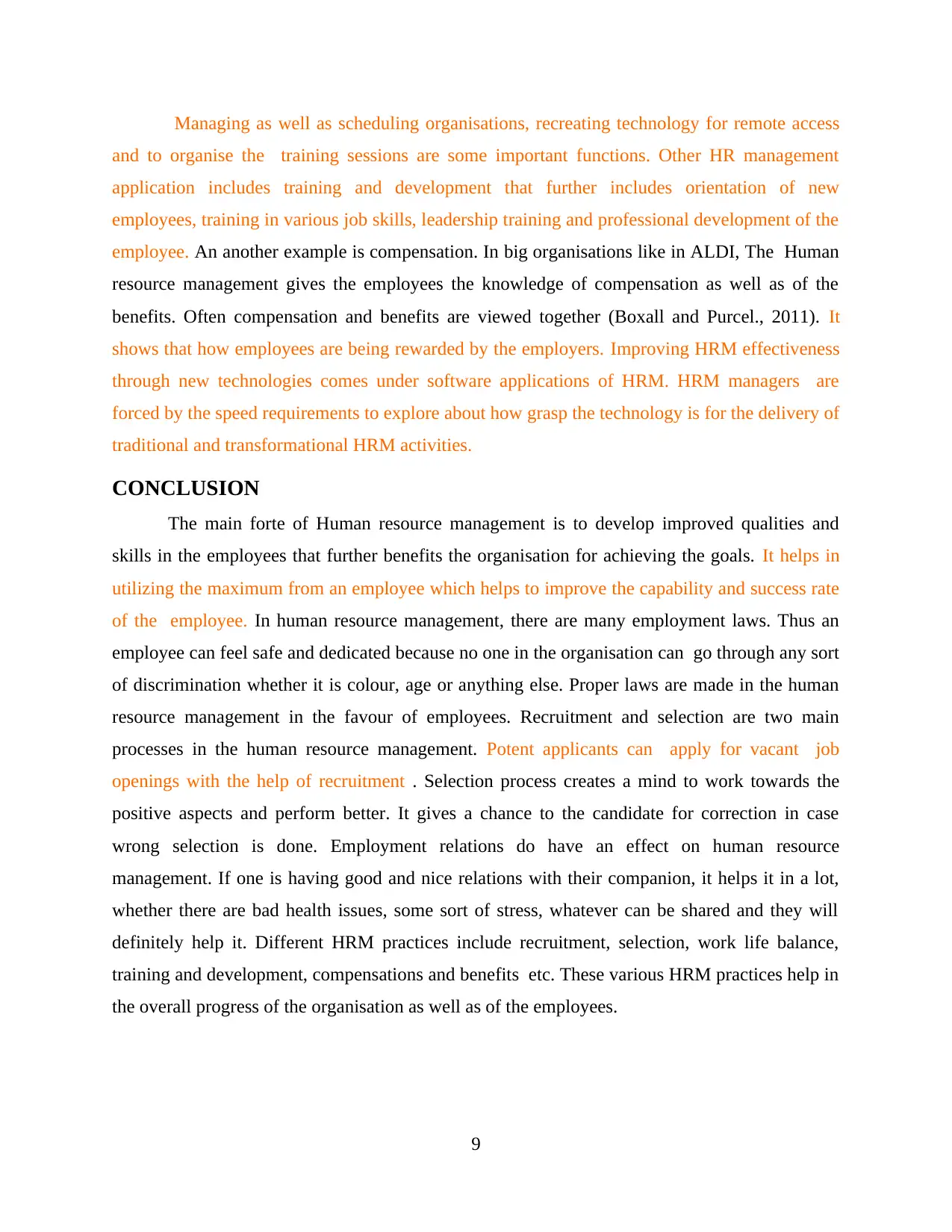
Managing as well as scheduling organisations, recreating technology for remote access
and to organise the training sessions are some important functions. Other HR management
application includes training and development that further includes orientation of new
employees, training in various job skills, leadership training and professional development of the
employee. An another example is compensation. In big organisations like in ALDI, The Human
resource management gives the employees the knowledge of compensation as well as of the
benefits. Often compensation and benefits are viewed together (Boxall and Purcel., 2011). It
shows that how employees are being rewarded by the employers. Improving HRM effectiveness
through new technologies comes under software applications of HRM. HRM managers are
forced by the speed requirements to explore about how grasp the technology is for the delivery of
traditional and transformational HRM activities.
CONCLUSION
The main forte of Human resource management is to develop improved qualities and
skills in the employees that further benefits the organisation for achieving the goals. It helps in
utilizing the maximum from an employee which helps to improve the capability and success rate
of the employee. In human resource management, there are many employment laws. Thus an
employee can feel safe and dedicated because no one in the organisation can go through any sort
of discrimination whether it is colour, age or anything else. Proper laws are made in the human
resource management in the favour of employees. Recruitment and selection are two main
processes in the human resource management. Potent applicants can apply for vacant job
openings with the help of recruitment . Selection process creates a mind to work towards the
positive aspects and perform better. It gives a chance to the candidate for correction in case
wrong selection is done. Employment relations do have an effect on human resource
management. If one is having good and nice relations with their companion, it helps it in a lot,
whether there are bad health issues, some sort of stress, whatever can be shared and they will
definitely help it. Different HRM practices include recruitment, selection, work life balance,
training and development, compensations and benefits etc. These various HRM practices help in
the overall progress of the organisation as well as of the employees.
9
and to organise the training sessions are some important functions. Other HR management
application includes training and development that further includes orientation of new
employees, training in various job skills, leadership training and professional development of the
employee. An another example is compensation. In big organisations like in ALDI, The Human
resource management gives the employees the knowledge of compensation as well as of the
benefits. Often compensation and benefits are viewed together (Boxall and Purcel., 2011). It
shows that how employees are being rewarded by the employers. Improving HRM effectiveness
through new technologies comes under software applications of HRM. HRM managers are
forced by the speed requirements to explore about how grasp the technology is for the delivery of
traditional and transformational HRM activities.
CONCLUSION
The main forte of Human resource management is to develop improved qualities and
skills in the employees that further benefits the organisation for achieving the goals. It helps in
utilizing the maximum from an employee which helps to improve the capability and success rate
of the employee. In human resource management, there are many employment laws. Thus an
employee can feel safe and dedicated because no one in the organisation can go through any sort
of discrimination whether it is colour, age or anything else. Proper laws are made in the human
resource management in the favour of employees. Recruitment and selection are two main
processes in the human resource management. Potent applicants can apply for vacant job
openings with the help of recruitment . Selection process creates a mind to work towards the
positive aspects and perform better. It gives a chance to the candidate for correction in case
wrong selection is done. Employment relations do have an effect on human resource
management. If one is having good and nice relations with their companion, it helps it in a lot,
whether there are bad health issues, some sort of stress, whatever can be shared and they will
definitely help it. Different HRM practices include recruitment, selection, work life balance,
training and development, compensations and benefits etc. These various HRM practices help in
the overall progress of the organisation as well as of the employees.
9
⊘ This is a preview!⊘
Do you want full access?
Subscribe today to unlock all pages.

Trusted by 1+ million students worldwide
1 out of 15
Related Documents
Your All-in-One AI-Powered Toolkit for Academic Success.
+13062052269
info@desklib.com
Available 24*7 on WhatsApp / Email
![[object Object]](/_next/static/media/star-bottom.7253800d.svg)
Unlock your academic potential
Copyright © 2020–2025 A2Z Services. All Rights Reserved. Developed and managed by ZUCOL.





